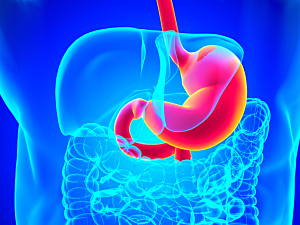Obesity is globally endemic and promotes numerous diseases. Successful bariatric surgery treats obesity-associated type 2 diabetes along with achieving sustained body weight loss and long-term metabolic changes.
To better understand the mechanisms of bariatric surgery, Stefan G. Tullius, MD, PhD, chief of the Division of Transplant Surgery & the Transplant Surgery Research Laboratory at Brigham and Women’s Hospital, and colleagues profiled 260 metabolites to identify those that are low in obese mice and highest after SG.
The researchers pinpointed taurodeoxycholic acid (TDCA), a bile acid, and L-valine, an essential amino acid, as agents that replicate many benefits of SG. In eLife, they say their results may lead to improved pharmacologic treatments of obesity and beneficial metabolic changes in humans.
TDCA and L-valine Levels After Surgery
In both mice and humans, TDCA and valine were critically involved in SG-induced weight loss:
- Obese mice had significantly decreased systemic levels of TDCA and valine
- After SG, obese mice displayed restored levels of both metabolites
- Pre- and postoperative serum samples from humans showed significant increases in TDCA and valine levels after SG
Treatment with TDCA/Valine
When the combination of TDCA and valine was administered to obese mice, systemic levels of these metabolites increased. The mice lost substantial weight and obesity-related insulin resistance was completely reversed, effects that were also noted when obese mice underwent SG.
Treatment of lean control mice with TDCA/valine did not affect weight.
Role of Melanin-concentrating Hormone
The effects of TDCA/valine appeared to be mediated, at least in part, by suppression of hypothalamic levels of melanin-concentrating hormone (MCH), an appetite-stimulating peptide:
- As expected, obese control mice that were deprived of food for 12 hours prior to procurement of hypothalamus tissue showed a pronounced increase in MCH levels
- In TDCA/valine–treated obese mice, however, no increase in MCH was detected in the hypothalamus
- When TDCA/valine treatment was combined with an MCH receptor antagonist, weight loss was diminished
New Direction for Drug Development
SG has a number of risks, including excessive bleeding, infection, blood clots and GI tract leaks. A nonsurgical treatment for patients with morbid obesity and obesity-associated metabolic disorders would be a highly desirable alternative.
